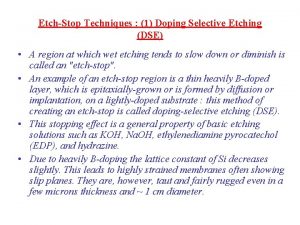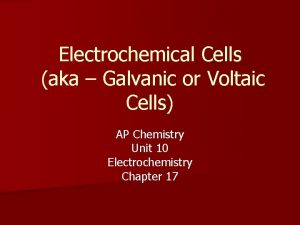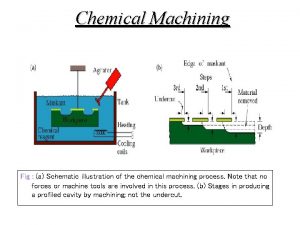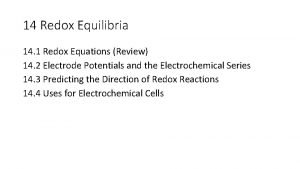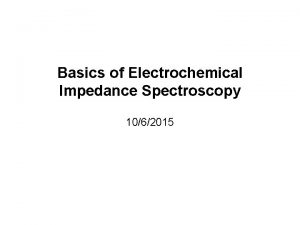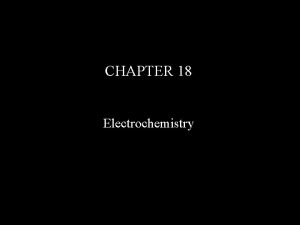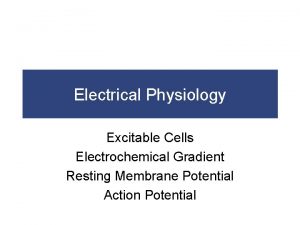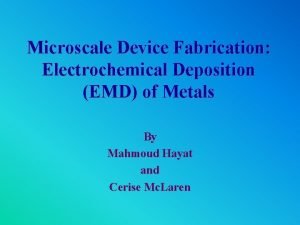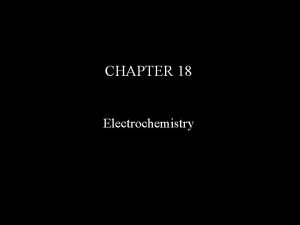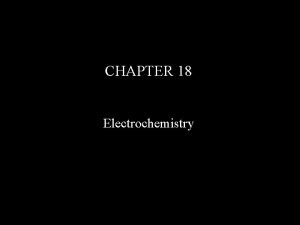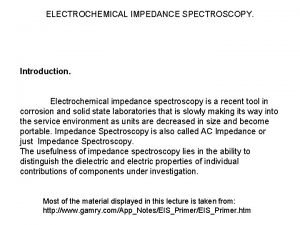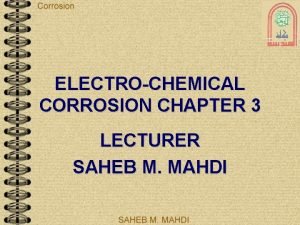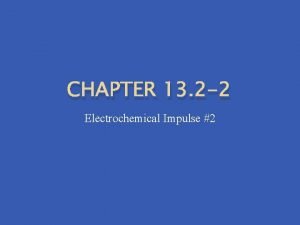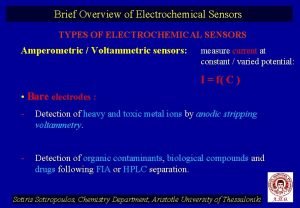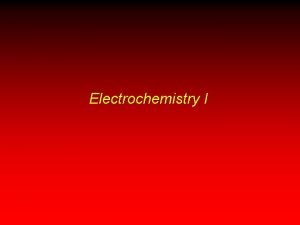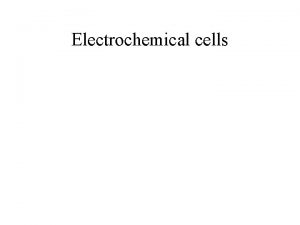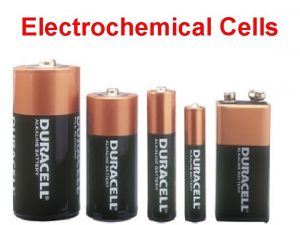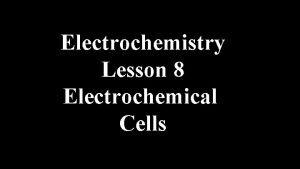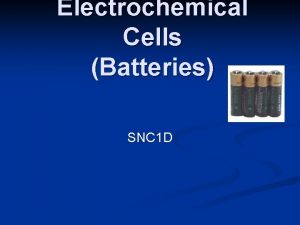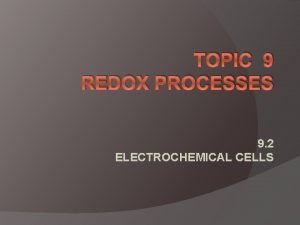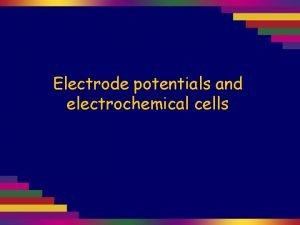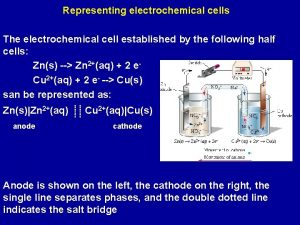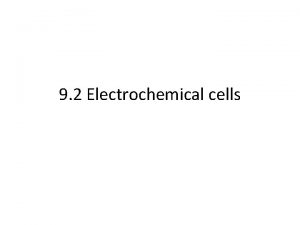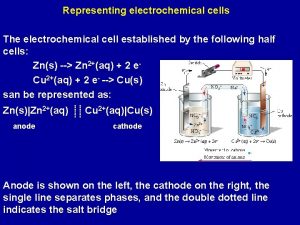Topic 9 REDOX Electrochemical cells Topic 9 2
















































- Slides: 48

Topic 9: REDOX – Electrochemical cells Topic 9. 2 & Topic 19. 1: Voltaic cells convert chemical energy to electrical energy and electrolytic cells convert electrical energy to chemical energy. Energy conversion between electrical and chemical energy lie at the core of electrochemical cells.

Important terms for this section • • • Electrochemical cells Voltaic (galvanic) cells Electrolytic cells Half-cells Electrode potential Anode Cathode Cell diagram convention Electromotive force (EMF) Cell potential/electrode potential • • • Standard hydrogen electrode (SHE) Standard conditions Standard half-cells • Selective discharge Standard electrode potential • Brine Standard reduction potentials • Electroplating Nernst equation • Galvanized iron Electrolyte • Sacrificial protection Electrodes Discharge Inert

Electrochemical cells • Voltaic cells: also called galvanic cells • Uses chemical reaction to generate electricity • Electrolytic cells • Uses electrical energy to drive a chemical reaction

Electrochemical cells: voltaic cells Voltaic cells generate electricity from spontaneous redox RXNs Example: zinc + copper(II) oxide Oxidation: Zn(s) Zn 2+(aq) + 2 e. Reduction: Cu 2+(aq) + 2 e- Cu(s) We can separate the reactions physically into half-cells to generate electrode potentials • http: //media. pearsoncmg. com/intl/ema/9781447959762_Chem. HL _Brown_Ford/animations/Chapter 9 p 439/index. html • • •

Electrochemical cells: voltaic cells • The charge separation is called electrode potential • There is an equilibrium of the ions and metal atoms • Where equilibrium lies (and strength of electrode potential) depends on reactivity of metal • Zinc lies toward the ions • Electrode potential is more negative • Copper lies toward the metal atoms • Electrode potential is more positive

Electrochemical cells: voltaic cells • Two half-cells, connected, make a voltaic cell • Connected by an external wire can allow e- to flow • E- will flow from the zinc to the copper • Electrodes: anode and cathode • Anode: Zn(s) Zn 2+(aq) + 2 e. An. Ox (neg charge) • Cathode: Cu 2+(aq) + 2 e- Cu(s) Red. Cat (pos charge)

Electrochemical cells: voltaic cells • • Needed: External electronic circuit connected to metal electrodes Voltmeter to record voltage generated Salt bridge (glass tube or paper) with aqueous ions • • Movement of ions neutralizes buildup of charge on a side and maintains potential difference Anions move from cathode to anode – opposes flow of e. Cations move from anode to cathode Does not interfere with charge, no voltage generated

Electrochemical cells: voltaic cells • • Cell diagram convention: a shorthand version of drawing a voltaic cell Single vertical line = physical boundary such as solid electrode and aqueous sol’n Double vertical lines = salt bridge Aqueous solutions of electrode next to salt bridge Anode on left; cathode on right e- flow from left to right (not universal) Spectator ions omitted! If a half-cell contains 2 ions, separate with a comma Note: e- always flow in external circuit • From anode cathode

Electrochemical cells: voltaic cells • Different half-cells can vary in voltage • Bigger difference in activity series larger electrode potential larger voltage generated

Electrochemical cells: voltaic cells - summary • Electrons flow from anode to cathode through external circuit • Anions migrate from cathode to anode through salt bridge • Cations migrate from anode to cathode through salt bridge • http: //media. pearsoncmg. com/intl/ema/ 9781447959762_Chem. HL_Brown_Ford/ani mations/Chapter 9 p 441/index. html


Electrochemical cells: voltaic cells • • Standard electrode potentials In order to compare half-cell electrode potentials, we need a point of reference The electromotive force (EMF) = the potential difference in the voltaic cell Cell potential/electrode potential = E • This is the voltage that depends on the difference in the two half-cells’ ability to undergo reduction • • Cannot measure only 1 half-cell. Need the flow of e- to measure the difference Need a point of reference!!! • Standard Hydrogen Electrode: SHE • This is the baseline for measuring and comparing electrode potentials

• http: //media. pearsoncmg. com/intl/ema/9781447959762_Chem. HL _Brown_Ford/animations/Chapter 9 p 441/index. html. Chapter 9 p 439/ index. html

Electrochemical cells • Standard Hydrogen Electrode (SHE) • Platinum metal electrode • Inert and won’t ionize • Will catalyze reaction for proton reduction • On surface, platinized platinum (finely divided platinum to increase s. a. and thus RXN rate) • Conditions: 1. 0 mol dm-3, p. H=0, 100 k. Pa, 278 K • The electrode sets up equilibrium of Hydrogen • This is assigned an electrode potential of 0 V • Therefore, connecting any other half-cell will give the actual electrode potential

Electrochemical cells • Measuring standard electrode potentials • The electrode potentials depend on: • • Ion concentrations Gas pressures Purity of substance Temperature • Thus, standard conditions must be maintained: standard half-cells • • • All solutions have concentration of 1. 0 mol dm-3 All gases at pressure 100 k. Pa All substances pure Temperature is 298 K IF the half-cell does not contain a metal, use platinum as the electrode

Electrochemical cells • When SHE is connected to another half-cell, the EMF generated is the standard electrode potential, Eθ • Positive Eθ indicates there is greater tendency to reduce than the hydrogen half-cell • Thus, hydrogen half-cell is anode = oxidized • The copper half-cell is cathode = reduced

Electrochemical cells • Usually, most metals have Eθ that is negative • Zinc is less reduced than hydrogen • Zinc = anode • Hydrogen = cathode

Electrochemical cells: standard reduction potentials • Since there is an equilibrium between reduction and oxidation, there is an agreed convention to standardize the data • Standard electrode potential (SEP) is always given for the reduction reaction • Oxidized species on the left, reduced species on the right • Called standard reduction potentials, Eθ • See section 24 of the data booklet for SEP of half-cells

Electrochemical cells: standard reduction potentials Notes: All Eθ refer to the reduction reaction Eθ do not depend on the total number of e-, so are not scaled up or down depending on the stoichiometric equation • The more positive the Eθ for the half-cell, the more readily it is reduced • • E- always flow toward the half-cell with the highest Eθ value • In voltaic cells • More negative electrode = anode and oxidation occurs there • More positive electrode = cathode and reduction occurs there

Electrochemical cells: standard reduction potentials • How do we apply the use of the standard electrode potential data? • 1. We can calculate the cell potential, Eθcell • 2. Determine the spontaneity of a reaction • This includes electrode potential and free energy change (Ecell and ∆G) • 3. Compare relative oxidizing and reducing power of half-cells

Electrochemical cells: standard reduction potentials • • • 1. We can calculate the cell potential, Eθcell From Eθ of two half-cells, we can calculate EMF From direction of e- flow, we can predict the outcome of REDOX RXNs Remember: higher Eθ is reduced (cathode), lower Eθ is oxidized (anode) Thus, • • • Notes: A. Use the reduction potentials for the calculations B. Even if you multiply the equation, DO NOT multiply the reduction potentials

Electrochemical cells: standard reduction potentials • 1. We can calculate the cell potential, Eθcell • Example:

Electrochemical cells: standard reduction potentials • 1. We can calculate the cell potential, Eθcell • Solution:

Electrochemical cells: standard reduction potentials • 2. Determine the spontaneity of a reaction • This includes electrode potential and free energy change (Ecell and ∆G) • • When Eθcell is positive, the reaction is spontaneous When Eθcell is negative, the reverse reaction is spontaneous

Electrochemical cells: standard reduction potentials • 2. Determine the spontaneity of a reaction • This includes electrode potential and free energy change (Ecell and ∆G) • • • n is the number of e- (moles of e-) transferred in the reaction F is the charge carried by 1 mol e-, also the Faraday constant = 96, 500 C mol -1 ∆G will be calculated in J so need to convert to k. J

Electrochemical cells: standard reduction potentials • 3. Compare relative oxidizing and reducing power of half-cells • Metals with low Eθ oxidized easily • More reactive, more likely to lose e-, thus stronger reducing agent • Metal with low Eθ will reduce metal with higher Eθ • Non-metal with high Eθ is reduced easily • More reactive, more likely to gain e-, thus stronger oxidizing agent • Non-metal with high Eθ will oxidize ions non-metal with lower Eθ • In general: • The higher the Eθ, the stronger the oxidizing agent • The lower the Eθ, the stronger the reducing agent

Electrochemical cells: standard reduction potentials • 3. Compare relative oxidizing and reducing power of half-cells • Example:

Electrochemical cells: standard reduction potentials • 3. Compare relative oxidizing and reducing power of half-cells

Electrochemical cells: Electrolytic cells • Voltaic cells are spontaneous that use chemical E to create electrical E • Electrolytic cells are non-spontaneous and must use an external source to push the e- through to create a chemical breakdown of a reaction • Electrolyte: molten ionic compound or solution of ionic compound • Redox occurs at electrodes when current is passed through electrolyte • Discharge: removal of charges of ions to create neutral products

Electrochemical cells: Electrolytic cells

Electrochemical cells: Electrolytic cells • • • Oxidation ALWAYS occurs at the anode Reduction ALWAYS occurs at the cathode That being said, the charges are reversed for electrolytic cells

Electrochemical cells: determining products in ECs

Electrochemical cells: determining products in ECs

Electrolytic cells: determining products – molten salts • Molten ionic salts: have very high melting points, so often used in industry • Ex: Na. Cl to extract Na metal (Aluminum oxide is a common industrial use too)

Electrolytic cells: determining products – solutions • Aqueous ionic solutions: have to contend with water ions as well • Predicting the products is a little trickier • • Factors to help determine what products will be made: 1. the relative Eθ values for each ion 2. the concentrations of the ions in the electrolyte 3. the type of electrode

Electrolytic cells: determining products – water • Electrolysis of water (includes Na. OH to help with conductivity) • 1. identify ions: • 2. write all half-equations

Electrolytic cells: determining products – water • Electrolysis of water (includes Na. OH to help with conductivity) • 3. write balanced equation: • Notice the Na from Na. OH is not discharged nor does it interfere with the reaction • 4. discuss observed changes:

Electrolytic cells: determining products – brine • Electrolysis of brine (Na. Cl in solution) • 1. identify ions: • 2. write all half equations:

Electrolytic cells: determining products – brine • • • Electrolysis of brine (Na. Cl in solution) 3. write balanced equation: 4. observations of reaction:

Electrolytic cells: determining products – Cu. SO 4(aq) • Electrolysis of Cu. SO 4(aq) • 1. identify ions: • • • Here, we have 2 options. Use inert electrodes or copper electrodes Inert: graphite or something else that does not interfere with the reaction Copper: you can imagine there will be copper everywhere! FUN!

Electrolytic cells: determining products – Cu. SO 4(aq) • Electrolysis of Cu. SO 4(aq) – inert electrodes • 3. Balanced equation: • 4. Observations:

Electrolytic cells: determining products – Cu. SO 4(aq) • Electrolysis of Cu. SO 4(aq) – copper electrodes • 2. identify ions: • • • 3. balanced equation: net movement of Cu 2+(aq) to form Cu(s) 4. observations: http: //media. pearsoncmg. com/intl/ema/9781447959762_Chem. HL_Brown_Ford/ animations/Chapter 9 p 463/index. html

Electrolytic cells: determining products – factors • • Q = charge in coulombs, C I = current in amperes, A t = time in seconds, s F = charge carried by 1 mol e- is a Faraday, 96500 coulombs

Electrolytic cells: determining products – factors • Charge on the ion makes a difference as well • Twice as much electricity is needed to produce 1 mole of Pb than Na

Electrolytic cells: electroplating • • • Electroplating: Coating metal onto another object (metal or conductive) Features: 1. electrolyte with metal ions wanted for the coating 2. cathode = object to be plated 3. anode = same metal as coating to replenish electrolyte Longer time = thicker coating

Electrolytic cells: electroplating • • • Purposes of electroplating Decorative, it’s pretty – coating other metals, like jewelry, objects, etc. Corrosion control (aluminum is resistant to corrosion vs. iron) • Sacrificial protection – put zinc on top of iron and it will corrode first • Improve function – chrome on car parts move smoother

Electrochemical cells: Summary

Electrochemical cells: Summary
 Cells and life lesson 1 answer key
Cells and life lesson 1 answer key Chapter 8 cellular reproduction cells from cells
Chapter 8 cellular reproduction cells from cells What is an organelle
What is an organelle Waters view with open mouth
Waters view with open mouth Label
Label Why dna is more stable than rna?
Why dna is more stable than rna? Prokaryotic cells vs eukaryotic cells venn diagram
Prokaryotic cells vs eukaryotic cells venn diagram Principal cells vs intercalated cells
Principal cells vs intercalated cells Prokaryotic cells vs eukaryotic cells
Prokaryotic cells vs eukaryotic cells Chlorocruorin
Chlorocruorin Why did robert hooke name cells “cells”?
Why did robert hooke name cells “cells”? Parafollicular
Parafollicular Prokaryotic vs eukaryotic cells
Prokaryotic vs eukaryotic cells Prokaryote vs eukaryote cells
Prokaryote vs eukaryote cells Masses of cells form and steal nutrients from healthy cells
Masses of cells form and steal nutrients from healthy cells Gamete vs somatic cell
Gamete vs somatic cell Khancademy
Khancademy Melvin bae
Melvin bae Electrochemical etch stop
Electrochemical etch stop Electrochemical machining animation
Electrochemical machining animation Electrochemical cell
Electrochemical cell Electrochemical machining advantages and disadvantages
Electrochemical machining advantages and disadvantages The electrochemical series table
The electrochemical series table Flow of anions and cations in an electrochemical cell
Flow of anions and cations in an electrochemical cell Cell reaction
Cell reaction Impedance definition
Impedance definition What are electrochemical series
What are electrochemical series Action potential propagation
Action potential propagation What is electrochemistry?
What is electrochemistry? The stage that creates an “electrochemical gradient”. *
The stage that creates an “electrochemical gradient”. * Vapor
Vapor Electrochemical deposition
Electrochemical deposition Electrochemical gradient
Electrochemical gradient Module 10 the nervous and endocrine systems
Module 10 the nervous and endocrine systems Electrochemical series order
Electrochemical series order Electrochemical series
Electrochemical series Electrochemical impedance spectroscopy
Electrochemical impedance spectroscopy Breathalyzer reaction
Breathalyzer reaction Mechanism of wet corrosion
Mechanism of wet corrosion Electrochemical theory of corrosion
Electrochemical theory of corrosion Giner electrochemical systems
Giner electrochemical systems Types of electrochemical corrosion
Types of electrochemical corrosion Electrochemical impulse
Electrochemical impulse Types of electrochemical sensors
Types of electrochemical sensors What is a clincher sentence
What is a clincher sentence What are the steps in narrowing down research topic
What are the steps in narrowing down research topic Analytical chemistry definition
Analytical chemistry definition Balance redox
Balance redox Leo goes ger
Leo goes ger


















